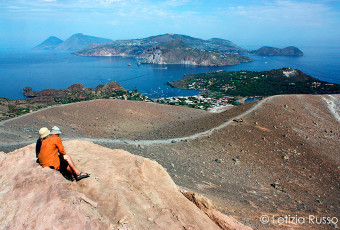Diving Vulcano
Clear waters full of life , the history made of eruptions, seaquakes, invasions, and piracy have always attracted sailors and tourists from all over the world. In spite of the touristic vocation this destination acquired during the last 50 years, it is possible to affirm that man’s intervention has not mutated or changed the wonderful landscape and such evocative and wonderful sea. Such multi-coloured seabed, a rocky coast full of creeks, stacks and caves, made of Vulcano the favourite destination for all those who are fond of scuba diving. There are a lot of sites where you can dive in Vulcano, each of them having its own fashion and always giving new emotions.
Capo Grillo
Difficulty: medium
Depth: 18mt 41mt.
Visibility: excellent.
Current: light.
The mooring occurs at 6m on the northern side of the island; the diving takes place along the volcanic ridge, coloured by several sponges and starfishes. At the depth of 18m a little cave creates an accessible creek full of shrimps to the skin-divers. The immersion continues admiring the ridge where it is not difficult to see lobsters, morays, and every kind of shoals. At the depth of 41m another creek creates a cave populated by a thick colony of shrimps, and musdea.
The wall of the Little Mermaid
Difficulty: very demanding
Depth: 12mt 45mt
Visibilità: Excellent.
Current: light
The diving occurs under the volcano’s slopes on the western side of the island. The point is not hard to locate thanks to the statue of the mermaid which surmounts a big rock at a few meters of the coast, the peak of a platform of volcanic rocks. At 12m of depth there is a stair where you will notice a wall; swimming around you will find lobsters, pentagon stars, sponges, and blackbelly rosefishes. For more expert skin-divers, at the depth of 35m it is possible to find some red corals. The scuba diving is exciting both for gas emissions from the seabed and fro the presence of a small creek which leads to the internal air bubble.
The landslide archipelago
Difficulty: medium
Depth: 25mt 45mt.
The diving occurs in front of the northern coast of Vulcanello between two hotels, easily seen from the sea. The discovery of the seabed starts with a light slope alternated to rocks and Posidonia oceanica (also known as Neptune Grass) till the depths of 10m, where a more steep descent starts, compound of stones, which become always bigger with the increase of the depth; they create an evocative seabed at 45m of depth.
Capo Grosso
Difficulty: medium
Depth: 20mt 40mt
Visibility: excellent
Current: Media
The diving on the northern-east side of Vulcano, where from the surface a vertical wall goes down till 50m on plateau. The diving is really evocative because it permits the discovery of the ravines which appear along this wall full of indentations and canals, and is populated by a myriad of the colonies of sponges, parrotfishes, anemone, astroides, and sabella spallanzanii. The numerous creeks create an ideal habitat for octopus, morays, blackbelly rosefishes and groupers.
Scoglio’s Quaglietto
Difficulty: medium
Depth: 20mt 30mt
Visibility: excellent
Current: slightly
Lo Scoglio del Quaglietto is among the most appreciated diving places of the Aeolian Islands. The rock is situated on the western coast of the Vulcano island, at a little distance from the coast. The diving is also right for the less expert skin-divers, and it occurs along the vertical wall of the rock until you reach a cave with many chambers, where the statue of Madonna surrounded by sabella spallanzannii is situated. In the second chamber there is a colony of prawns living. Adjacent the cave, on the seabed, a landslide makes the landscape full of creeks, a perfect shelter for groupers, lobsters, and octopus.
Capo Testa Grossa
Difficulty: Difficult
Depth: 20mt 50mt
The diving is recommended to the most expert skin-divers. Capo Teresa Grossa is situated on the western coast of the Vulcano island. The discovery of the seabed starts in the northern bay of the header next to rocks. One of these rocks creates a vertical wall populated by sponges. The diving continues going towards the extreme point of the header, where initially you follow a nearby vertical wall till you arrive to a steep landslide reaching depths major then 50 metres. The landslide creates a perfect habitat for burrow fishes; in fact it is not difficult to meet groupers, morays, octopus, lobsters ,and breams.







